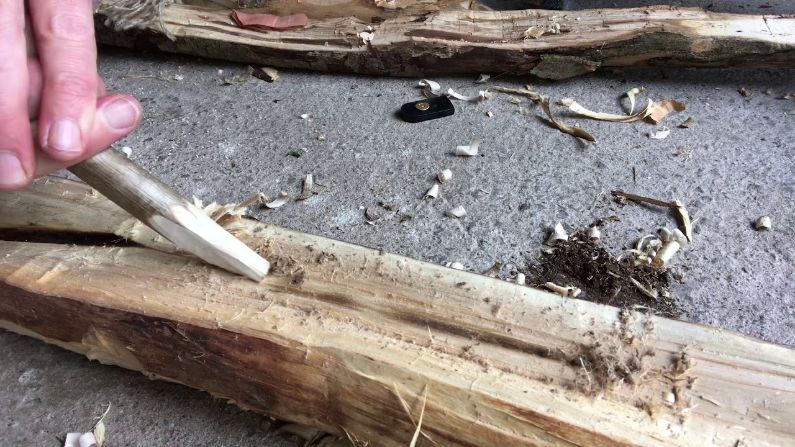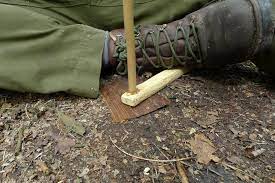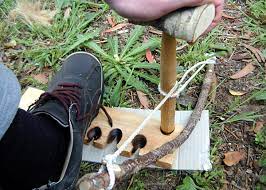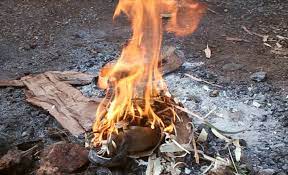You can stay warm and keep wild animals away by building a fire. It also helps you prepare meals in the wilderness and provides light. A fundamental bushcraft skill is knowing how to make a fire with sticks.
Contrary to what you may have seen in the movies, starting a friction fire does not just require rubbing a few sticks together. As an alternative, it necessitates a finely curated assortment of natural materials, a careful method, and a lot of practice.
Here is a detailed explanation of how to start a fire with sticks and the equipment you’ll need.
What To Consider Before Starting a Fire?
Prior to lighting a fire, there are many different things to take into account.
To prevent bush fires, make sure the location you pick is sufficiently far from any bushes, plants, or trees. Any plants should be at least 6 feet away from the location you choose. Make sure the ground is bare before starting a fire.
Sticks should never be used to start a fire on grass. If there isn’t any bare ground available, you might have to clear the area of vegetation and dig a section of bare ground there. Before beginning the fire-making process, clear the area of any dry plant material or vegetation because they are flammable.
You’ll need to put out the fire and contain the sticks once they start burning. You can achieve this by building a stone fire enclosure. Mark the area where you will start the fire using this enclosure.
Materials You Need To Start A Fire With Sticks
Tinder
These are small, lightweight materials that aid in igniting a fire. There are several varieties of tinder that are simple to locate, including:
- wadded paper
- cardboard strips or shavings
- wood shavings
- wax
Alternatively, if you didn’t pack any tinder in your survival kit, you could use dry leaves or bark. Carry homemade tinder whenever you can to make starting a fire easier, especially during the rainy season.
Kindling
This next layer is also necessary for making fire. When they come into contact with a burning tinder, medium-sized sticks known as kindling readily ignite. They could be little fire sticks, twigs, or bigger pieces of bark.
The diameter of the branches and twigs you select should be between 0.5 and 0.5 inches. Any larger, and the kindling won’t ignite quickly from the tinder. Your kindling needs to be dry if you want to start a fire quickly.
Wood Logs
To start a fire and keep it going for a long time, wood logs are essential. They serve as your fire’s center. Your fire won’t burn long enough to keep you sufficiently warm if you don’t have enough wood logs.
The size of the firewood varies depending on what is available. However, the diameter of each piece of firewood you use should be between 1 and 5 inches. They must not be excessively large.
To keep your fire going, all you need is some large enough pieces of firewood. Keep in mind that larger pieces of firewood take longer to ignite but burn for longer once they do.
A full night’s worth of wood should be available. You’ll also need an axe to chop your logs. It’s important to note that different types of wood burn at various rates. Oak and hardwood take some waiting but are worth it.
While softwood also makes crackling noises, it is better suited for beginners. Cedar is an illustration of softwood. Assemble the materials to construct your fire structure once you have all the necessary supplies.
Methods For Starting A Fire With Sticks
Fire Plow Method

Because it requires the least amount of setup time to build a fire with sticks, the fire plow technique was my favorite during my lazy teenage years. Furthermore, I didn’t experience any teen humiliation as a result.
- A slab of wood with flat surfaces on both sides can be found or made. Your “hearth board” or “fireboard” will be this.”
- Create a long, fairly thick groove or trough on the surface of the fireboard.
- Find a straight stick that is about the same length and thickness as a heavy-duty screwdriver.
- Almost as wide as the groove in your base log, whittle one end of your stick into a point.
- To catch any hot dust or embers that leak from the trough, place a piece of bark or another dry container at the base of the base log.
- Choose a comfortable stance above the log because you will be in this position for some time.
- With downward pressure, begin rubbing your stick’s pointed end through the log’s groove. As the wood heats up, start out slowly and pick up the pace. You’ll start to notice black flakes or dust forming.
- Rub continuously until smoke specks appear at the groove’s bottom.
- Pause to give the black, smoldering dust some oxygen. Hot dust ought to cling to one another a little.
- The black dust flakes will start to resemble tiny glowing embers when you blow gently on them.
- Place the tiny embers in the center of your bundle of tinder.
- Wrap the embers in the tinder bundle.
- Gently blow into the bundle until you see it begin to burn.
- In the center of your fire lay, place the tinder bundle that is currently burning.
A thorough description of the fire plow technique is available here: How to start a fire using the fire plow method
Hand Drill Method

Even though I have literally set myself on fire after using one of the other methods, I still maintain that the hand drill fire method is the most masochistic one on this list.
- Find or create a fireboard (also called a hearth board) that is flat on both sides.
- Untangle any knots with a long, straight stick. This will serve as your fire drill or fire stick.
- Make the fire drill’s tip into a dull, rounded contact point.
- Make a hole the same width as your drill with your knife in the fireboard.
- To make sure it fits properly, work the fire stick into the hole and spin it a few times.
- To the edge of the hole you just carved, carve a notch into the side of the hearth board. This groove will become congested with the hot dust you produce.
- Place something under the notch to catch the hot dust and place the fireboard down on a flat, dry surface.
- To hold the board steadily, find a comfortable position (I did this by placing it under my left foot).
- Incorporate the fire drill into the hearth board’s hole.
- Put your hands on the top of the stick, one on each side, and place the stick in the flesh of your palms. Pretend to be praying to the fire gods above by keeping your fingers straight out.
- Rub your hands together, either because you’re cold (which you probably are) or because you’re a cartoon villain planning the death of your foe. Muah ha ha!
- The fire drill should be firmly seated in the hole in the hearth board by applying downward pressure as you rotate it back and forth between your two hands.
- Offer prayers to the god or goddess in which you have the most faith.
- As you continue to rub, change which part of your hands make contact with the stick to lessen the piercing pain.
- heat should be produced by enough friction.
- Continue drilling after you notice smoke, exerting more pressure, until you have a small mound of smoldering black dust in the board groove.
- The center of your tinder bundle should now contain the black dust.
- Squeeze your tinder bundle lightly and blow on it until it catches fire.
- Now that you have a fire going, you masochist, tend to your poor hands.
Bow Drill Method

To master the Bow Drill friction fire technique and feel confident applying it in a survival situation, regular practice is required.
- Carve a slight round dent inside the middle edge of your fireboard
- Make a V-shaped incision at the base of a middle edge
- Bend the bow stick to form a half-moon and tightly tie it with your bootlace
- Lay out your board on the floor. Now place some tinder under the incision
- To increase stability, put your foot on the board. Now coil your bowstring around your drill and rest it along with the round dent
- With light pressure, place your socket at the top of your drill, then swing your bow back and forth. By doing this, you’ll cause the drill to spin and a cloud of hot, black powder to fall onto your tinder. The tinder should start to burn soon. You can now move your fire into the fire pit.
How Long Does It Take To Start A Fire With Sticks?
This question does not have a universally applicable response. However, some skilled survivalists can start a fire with sticks in just 10 to 15 minutes. Others who used a bow fire starter accomplished the feat in the same amount of time.
You must take into account a number of variables, such as the type of wood, the humidity in your firewood, and the weather. Your ability to maintain pressure while trying to start the fire is crucial.
It will take some practice if you’re new to these survival skills before you can start a campfire without assistance. Creating any dust, for instance, might take you up to an hour. But as you gain experience and put your fire-starting abilities to the test, you’ll be able to shorten this time.

